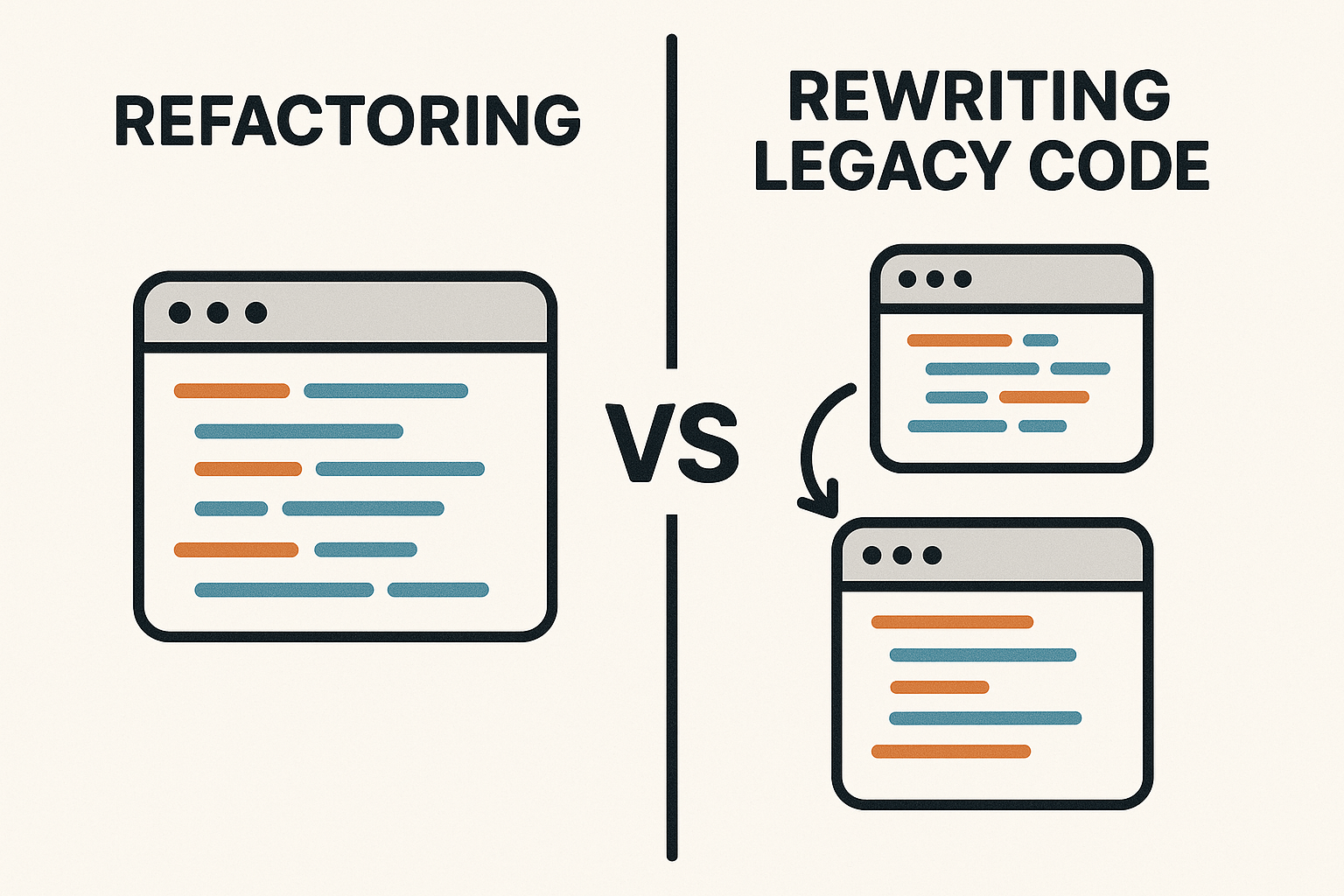Ever taken on a codebase so tangled that you felt like an urban planner trying to modernize a medieval warren of narrow alleys? That was me staring at our two-year-old PHP monolith, half of which nobody remembered touching. Should we patiently untangle each street (i.e., refactor), or bulldoze and rebuild from scratch (i.e., rewrite)? Spoiler: neither choice is free—so let’s unpack the trade-offs, share some laughs (and tears), and give you a roadmap for choosing wisely.
The Foundations—What Is Refactoring, and What Is Rewriting?
Refactoring means changing the internal structure of code without altering its external behavior. Think of it as renovating an old house: you reinforce beams, update the wiring, and repaint the walls—but guests still enter through the same front door, and the rooms look familiar. Proper refactoring leverages small, incremental improvements: extract functions, introduce design patterns, improve naming, split large The magic here is that you keep the existing tests (or write new ones) and gradually improve safety and readability.
Rewriting means starting over: you toss out almost all the old code and build a new system that replicates—or enhances—the existing It’s like bulldozing that medieval district and erecting a glass skyscraper in its place. You gain a fresh architecture, modern tools, and up-to-date libraries—but you risk budget overruns, schedule slips, and the dreaded “we lost a feature” scenario.
Have you ever tried refactoring only to uncover so many hidden dependencies you wished you’d just started from scratch? Or launched a rewrite that turned into a two-year odyssey? Neither path is a silver bullet—each carries psychological and practical costs.
A Step-By-Step Guide to Choosing and Executing
Step 1: Assess Code Health and Business Needs
Gather metrics and stakeholder input. How many critical bugs does the legacy code produce each month? How often do teams avoid touching it for fear of regressions? If you’re patching every week and burning cycle time, refactoring might relieve technical debt faster. If the codebase is untestable and your business is pivoting to new requirements, a rewrite could make sense.
Anecdote: On one project, we spent two months refactoring a reporting module—only to realize halfway through that the KPIs had changed entirely. We’d refactored the wrong thing! Today, we always lock in requirements before any major refactor.
Step 2: Prototype and Proof of Concept
If you’re leaning toward rewrite, build a small PoC that implements a critical slice of functionality in the new stack. This exposes hidden complexities: authentication flows, third- party integrations, performance bottlenecks. For refactoring, pick one pain point—like a monolithic UserController—and apply your chosen patterns (e.g., extract service classes, introduce repositories). Measure how much effort that small change required and whether tests caught regressions.
Step 3: Plan Your Iterations
For Refactoring: Create a prioritized backlog of small, safe refactoring tasks. Each ticket should be scoped to one class or Tie each change to a test or add tests first (the “Red-Green-Refactor” TDD cycle). Celebrate when your code coverage climbs and complexity metrics drop.
For Rewriting: Break the rewrite into vertical slices—complete features that run side- by-side with the old system. Use the Strangler Fig pattern: route a sliver of traffic to the new code, gradually increasing it until the old modules can be retired.
Step 4: Migrate Data and Integrations
Whether you refactor or rewrite, you still need to migrate schemas, APIs, and data flows. Build migration scripts, version your database, and coordinate releases so that old and new components interoperate seamlessly. I remember a Friday release where our migration script accidentally duplicated ten thousand user records—thankfully, we had a rollback plan!
Common Pitfalls and How to Dodge Them
- Analysis Paralysis: Spending months debating pros and cons is a recipe for Set a decision deadline and stick to it—then revisit after your first iteration.
- Underestimating Testing: A refactor without tests is like tightrope walking Invest in unit and integration tests before touching code.
- Under-Resourcing the Rewrite: Rewrites can balloon Assign a small, dedicated team and isolate them from urgent bug-fix work to maintain focus.
- Neglecting Stakeholders: Keep product owners and QA in the A silent rewrite can deliver missing features and surprise users—never fun in production.
Conclusion
Refactoring and rewriting legacy code aren’t mutually exclusive: many teams combine both— refactoring high-value modules while rewriting unmaintainable portions. The key is to ground your decision in solid measurement (test coverage, bug rate), clear business objectives, and incremental planning. Ready to tackle your dusty codebase? Grab your teammate, sketch out criteria, and choose your own adventure: renovate or rebuild. Either way, with a disciplined, step-by-step approach, you’ll emerge with cleaner, more maintainable code—and maybe even a little bit of fun along the way.





